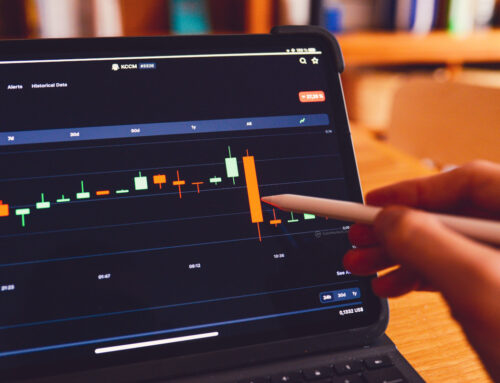As a swing trader, you have an arsenal of technical indicators you can rely on to help you uncover opportunities and execute trades. However, among the most frequently used indicators are moving averages. From the SMA (simple moving average) to the EMA (exponential moving average), to the MACD (moving average convergence divergence) – there are quite a few different moving averages you can rely on. Further complicating matters is the time frame for which each of these indicators can be looked at through. There’s the 5-day moving average, 20-day moving average, and even a 250-day moving average – among many others.
All this variety can lead to analysis paralysis – as you ponder all the different indicators and end up stuck in your thoughts, failing to actually gain confidence in your decision-making. That’s why in this article, we’re going to answer a common question our community asks: what is the best moving average for swing trading?
Keep in mind – each of these moving averages has its place in your arsenal. However, some are more insightful than others. And if you had to rely on just one for swing trading in particular, our recommendation would be the 20-day simple or exponential moving average – and we’ll explain why later on. First, let’s explain what moving averages are in the first place, why they’re so important, and how you can use them in your trading plan.
Featured Courses:
What Exactly are Moving Averages?
We recently wrote a complete guide discussing the best swing trade indicators. There, we touched on moving averages in general and their variations. But in this section, we’re going to go a bit deeper.
A moving average is simply a calculation that takes the average price of a security over a certain period of time – and then plots that data on a chart. For example, if you’re looking at a 50-day moving average (MA), you’re essentially taking the past 50 days’ worth of closing prices and averaging them out. This gives you a good idea of the overall trend of a stock.
The Different Moving Averages Explained
There are different types of moving averages – as we briefly mentioned before. The most common ones used in trading are the SMA (simple moving average), EMA (exponential moving average), and MACD (moving average convergence divergence). However, there are quite a few others worth mentioning as well. We’ll break them all down below – starting with the SMA.
SMA (Simple Moving Average)
The SMA is the most basic type of moving average. As we briefly touched on, it simply takes the past X number of days’ worth of closing prices and averages them out. For example, if you’re looking at a 50-day SMA, you’re taking the past 50 days’ worth of closing prices and averaging them.
EMAs (Exponential Moving Average)
An exponential moving average (EMA) puts more weight on recent price action than a simple moving average does. The formula for an EMA includes a multiplier, which essentially determines how much weight is given to the most recent price. The larger the multiplier, the more weight that’s given to the most recent price – making it more responsive to recent price changes.
SMMA (Smoothed Moving Average)
A smooth moving average is simply an EMA that has had its multiplier reduced. This makes it less responsive to recent price changes than an EMA – but more responsive than a standard SMA.
LWMA (Linear Weighted Moving Average)
A linear weighted moving average (LWMA) is similar to an EMA in that it gives more weight to recent price action. However, the way the LWMA calculates weighting is different. With an LWMA, the weight given to each closing price declines linearly – as opposed to exponentially like with EMAs.
MACD (Moving Average Convergence Divergence)
The MACD is a bit more complex than a simple moving average or EMA. It’s actually the difference between two exponential moving averages – the 26-day EMA and the 12-day EMA. MACD lines are plotted above and below a zero line, which signals bullish and bearish momentum, respectively.
There are quite a few other types of moving averages we could touch on – including the Hull Moving Average (HMA), Triple Exponential Moving Average (TEMA), Kaufman’s Adaptive Moving Average (KAMA), Vidya’s Linear Regression Slope (VLSM), and many others. However, we don’t want to get too far into the weeds. The purpose of this article is to help you discover the best moving averages to use for swing trading – so with that said, let’s break down the pros and cons of each style.
How Time Frames Factor Into Moving Averages
Just as there are different types of moving averages, each of these can be broken down further by time frame. We wrote a complete guide on which time frame is best for swing trading if you’d like to learn more. However, we’ll touch on the basics here. There are three main time frames to consider when swing trading: short-term, intermediate-term, and long-term.
Short-Term Moving Averages
A short-term moving average is any MA that has a time frame of 20 days or less. The most common MAs used in this time frame are the 50-day, 100-day, and 200-day MAs.
Intermediate-Term Moving Averages
An intermediate-term moving average is any MA with a time frame of 21 days to 200 days. The most popular MAs in this category are the 100-day, 150-day, and 200-day MAs.
Longer-Term Moving Averages
A long-term moving average is an MA with a time frame of 200 days or more. The most common ones used by traders are the 200-day and 300-day MAs.
So – What are the Best Moving Averages for Swing Trading?
Now that we’ve gone over the different types of moving averages, it’s time to answer the question – what are the best moving averages for swing trading? The answer isn’t as simple as you might hope. The best moving average for swing trading depends on your trading goals and risk tolerance. That said, there are certain types of moving averages that tend to work better than others for swing trading. In general, exponential moving averages (EMAs) are a good choice – as they’re more responsive to recent price action than simple moving averages (SMAs).
Another thing to keep in mind is the length of the moving average. A longer moving average will smooth out some of the noise and help you better identify the overall trend. Conversely, a shorter moving average will be more responsive to recent price changes – which can be helpful if you’re looking to enter or exit a trade quickly. For swing trading, in particular, most investors benefit from sticking with intermediate time frames – such as a 20-day moving average. However, the 50-day moving average is another great option. It’s a solid balance of short and long-term insight.
Ultimately, it’s up to you to experiment with different moving averages and find what works best for your trading style. As we always say – the best way to learn is by actually trading. Starting swing trading with a small account – or even paper trading with fake money – will help you determine which MA’s provide you with the greatest insights for your unique trading strategy. And, no matter which moving average you end up using, we’re going to break down how you can actually go about using it below.
How to Use Moving Averages for Swing Trading
Now that we’ve answered the question – what are the best moving averages for swing trading? – it’s time to show you how to actually use them. Moving averages can be used in a few different ways when swing trading. We’re going to touch on three of the most popular methods below.
Identify the Overall Trend
The first way to use moving averages is to simply identify the overall trend. This is probably the most common way that MAs are used by traders. By plotting a MA on your chart, you can quickly see whether a stock is in an uptrend, downtrend, or sideways pattern.
An uptrend occurs when the stock is making higher highs and higher lows. In other words, each successive peak and trough is higher than the last. A downtrend is the opposite – with the stock making lower lows and lower highs. And, finally, a sideways or range-bound market occurs when the stock isn’t making any clear directional moves – it’s just bouncing around between support and resistance levels.
Time Your Entry
Once you’ve identified the overall trend, you can use moving averages to help time your entry into a trade. For instance, let’s say you’re looking at a stock in an uptrend that suddenly starts to pull back towards its MA. This could be an opportunity to buy the dip – as long as the MA holds as support. Conversely, if a stock in a downtrend starts to rally back up towards its MA, this could be a good time to sell or short the stock.
The key here is to wait for confirmation before taking a trade. In other words, don’t just blindly buy or sell a stock every time it touches its MA. Instead, look for candlestick patterns or other indicators that signal that the trend is still intact – even after the pullback. This will help you avoid false breakouts and increase your chances of success.
Exit Your Trades
Moving averages can also be used to help you exit your trades – either at a profit or a loss. For example, if you’re in an uptrending stock and the price starts to drop below its MA, this could be a sign that the trend is reversing and it’s time to get out. Similarly, if you’re in a downtrending stock and the price starts to move back above its MA, this could be a sign that the trend is losing momentum and it’s time to take your profits.
Of course, it’s always best to use other technical indicators in conjunction with MAs to confirm your exit signal. For instance, you could wait for the RSI indicator to become overbought or oversold before taking action. Or, you could look for candlestick patterns like bearish reversals or bullish reversals.
A Simpler Way to Find Opportunities, Entries, & Exits: No Manual Analysis Necessary!
Even using the best moving averages for swing trading can become time-consuming, complicated, and at times, inaccurate. Fortunately, there is a better way to conduct analysis that requires no manual work on your end. You can effortlessly find opportunities and identify entry/exit points – no guesswork, no emotion. Just sound investment principles that have been perfected over the course of the past decades. Sounds too good to be true? It’s not – our stock forecast website is the #1 resource for investors looking to simplify things while earning better returns.
The VectorVest system boils down all fundamental and technical analyses into three proprietary ratings: Relative Value, Relative Safety, and Relative Timing. These make up the VST (value, safety, timing) rating a stock is given. All of these ratings are easy to understand, ranked on a scale of 0.00-2.00. The closer to 2.00, the better a stock is performing against the average. And, this system provides investors with a clear buy, sell, or hold recommendation for any given stock. You can still use technical indicators – like moving averages – to help validate opportunities and time entries/exits. But, the point is that you don’t have to. Wouldn’t it be nice to earn more profits while spending less time in front of a screen? That’s the value behind VectorVest.
Our system also grants investors insights into what market sentiment is at any given time. With prebuilt searches for the hottest stocks at any given time, finding your next opportunity is as straightforward as it gets. You can even take your investments on the go with our mobile stock advisory. Want to see it in action? Get your free stock analysis here!
Final Thoughts on the Best Moving Averages for Swing Trading
So, what are the best moving averages for swing trading? In our opinion, you can’t beat the 20-day or 50-day SMA or EMA. These give swing traders all the insights they need to uncover trends and find the perfect entry/exit point. And while using moving averages can be beneficial, there is an easier, more straightforward way to trade. With VectorVest, you don’t have to spend nearly as much time staring at charts. And you’ll enjoy a greater rate of success along the way. What more could you ask for?
If you want to learn swing trading more, find great resources in our blog – such as our articles on swing trading for beginners, swing trading pros and cons, or swing trading vs scalping.






Leave A Comment